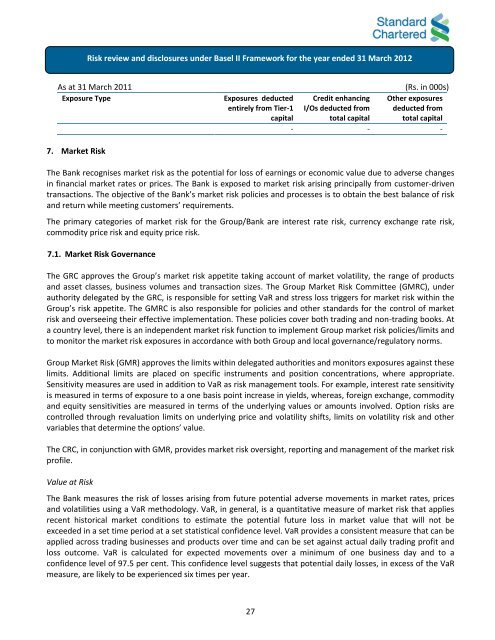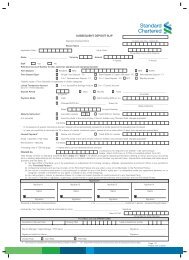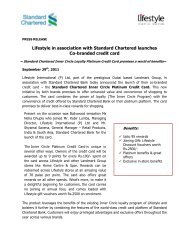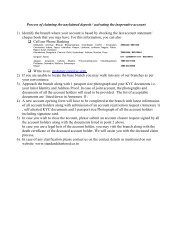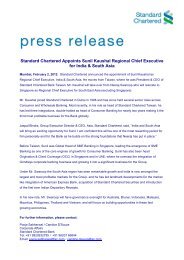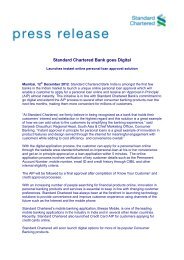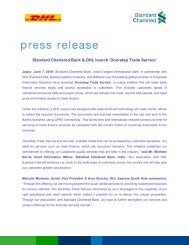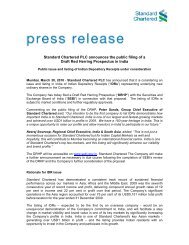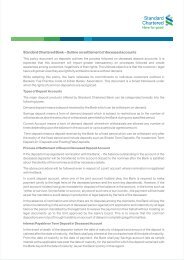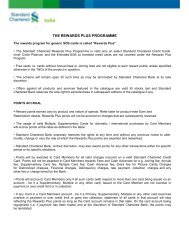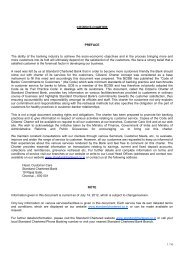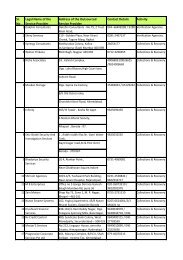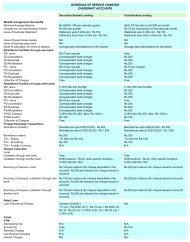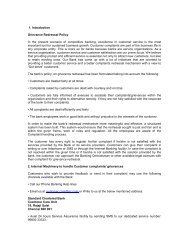March 12 - Standard Chartered Bank
March 12 - Standard Chartered Bank
March 12 - Standard Chartered Bank
You also want an ePaper? Increase the reach of your titles
YUMPU automatically turns print PDFs into web optimized ePapers that Google loves.
Risk review and disclosures under Basel II Framework for the year ended 31 <strong>March</strong> 20<strong>12</strong><br />
As at 31 <strong>March</strong> 2011 (Rs. in 000s)<br />
Exposure Type<br />
Exposures deducted<br />
entirely from Tier-1<br />
capital<br />
Credit enhancing<br />
I/Os deducted from<br />
total capital<br />
Other exposures<br />
deducted from<br />
total capital<br />
- - -<br />
7. Market Risk<br />
The <strong>Bank</strong> recognises market risk as the potential for loss of earnings or economic value due to adverse changes<br />
in financial market rates or prices. The <strong>Bank</strong> is exposed to market risk arising principally from customer-driven<br />
transactions. The objective of the <strong>Bank</strong>’s market risk policies and processes is to obtain the best balance of risk<br />
and return while meeting customers’ requirements.<br />
The primary categories of market risk for the Group/<strong>Bank</strong> are interest rate risk, currency exchange rate risk,<br />
commodity price risk and equity price risk.<br />
7.1. Market Risk Governance<br />
The GRC approves the Group’s market risk appetite taking account of market volatility, the range of products<br />
and asset classes, business volumes and transaction sizes. The Group Market Risk Committee (GMRC), under<br />
authority delegated by the GRC, is responsible for setting VaR and stress loss triggers for market risk within the<br />
Group’s risk appetite. The GMRC is also responsible for policies and other standards for the control of market<br />
risk and overseeing their effective implementation. These policies cover both trading and non-trading books. At<br />
a country level, there is an independent market risk function to implement Group market risk policies/limits and<br />
to monitor the market risk exposures in accordance with both Group and local governance/regulatory norms.<br />
Group Market Risk (GMR) approves the limits within delegated authorities and monitors exposures against these<br />
limits. Additional limits are placed on specific instruments and position concentrations, where appropriate.<br />
Sensitivity measures are used in addition to VaR as risk management tools. For example, interest rate sensitivity<br />
is measured in terms of exposure to a one basis point increase in yields, whereas, foreign exchange, commodity<br />
and equity sensitivities are measured in terms of the underlying values or amounts involved. Option risks are<br />
controlled through revaluation limits on underlying price and volatility shifts, limits on volatility risk and other<br />
variables that determine the options’ value.<br />
The CRC, in conjunction with GMR, provides market risk oversight, reporting and management of the market risk<br />
profile.<br />
Value at Risk<br />
The <strong>Bank</strong> measures the risk of losses arising from future potential adverse movements in market rates, prices<br />
and volatilities using a VaR methodology. VaR, in general, is a quantitative measure of market risk that applies<br />
recent historical market conditions to estimate the potential future loss in market value that will not be<br />
exceeded in a set time period at a set statistical confidence level. VaR provides a consistent measure that can be<br />
applied across trading businesses and products over time and can be set against actual daily trading profit and<br />
loss outcome. VaR is calculated for expected movements over a minimum of one business day and to a<br />
confidence level of 97.5 per cent. This confidence level suggests that potential daily losses, in excess of the VaR<br />
measure, are likely to be experienced six times per year.<br />
27


